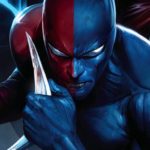 Writers: David Hine, Brian Haberlin
Writers: David Hine, Brian Haberlin
Artist: Brian Haberlin
Colorist: Geirrod Van Dyke
Letterer: Francis Takenaga
Editor: Melanie Hackett
Lead Developer: David Pentz
Production: Diana Sanson, Hannah Wall
Communications: Marc Lombardi
Ancient Monster: Jim Valentino
Publisher: Image Comics
When two cultures from different planets both try to lay claim to a third planet, you know there’s going to be conflict. Sonata #1 introduces us to the Rans, a peace and nature-loving civilization, and the Tayans, an industrial and warrior culture, as they both seek to claim to a planet known as the Promised Land. As both groups try to escape the environmental and resource problems of their home planets, they bring their old problems with them … as humans are wont to do.
As our titular heroine Sonata seeks to assure the native Lumani race that the Rans will support them, the Rans accidentally create a disaster that immediately threatens the Lumani village. This leads Sonata to a mysterious place that might give her clues about the Sleeping Giants that inhabit the planet. Are they a bloodthirsty threat, or are they really the old gods of legend?
There are two aspects of Sonata that are almost immediately apparent: the world-building is thoroughly imaginative and the artwork is absolutely spectacular. The steampunk, sci-fi fantasy world gave me shades of everything from H.R. Giger to the world of Horizon: Zero Dawn. Not only is there careful attention to detail in the artwork but also the system of political tension, different civilization structures, and native creatures are all worthy of praise.
Unfortunately, that’s about where my interest in the book ends. While there is a lot of imagination put forth in this book, the plot and the characters felt a little stock to me. It took a while for the story to get going since we had to spend some time getting introduced to the characters, the world, and their current predicament. By the time it starts to break out of the “I’ve seen this before” mold, the book is over.
As interesting as political intrigue might be, the tension between a more eco-friendly culture vs. a warring, industrial culture is kind of a tired trope. It’s like an expanded version of Ewoks vs. Stormtroopers. Sonata is your typical headstrong, ambitious protagonist who is told she’s too young and reckless to do anything useful but somehow stumbles ass-backwards into a far more important storyline than her elders. There’s also potential for a Romeo and Juliet-type scenario, but as good as tried-and-true story building blocks can be, it almost feels like another safe peg to hang the story on just so we can have this cool world-building and art.
Finally, I had an issue with the lettering within the voiceover narrative Sonata gives. It could have been the low-res review copy I read, but the white text on top of semi-chromatic light green was really hard to read. I’ve seen other preview images where the text was a lot clearer, so I’m hoping those of you who decide to pick up a hard copy aren’t half squinting to read the text.
All in all, it wasn’t a bad book, but with the amount of positives, it felt like the story and the characters deserved a lot more than they were given. I’m hoping issue #2 provides a clearer divide of what makes this story unique as opposed to a story that has been rehashed a thousand times … but maybe with less beautiful skin.




